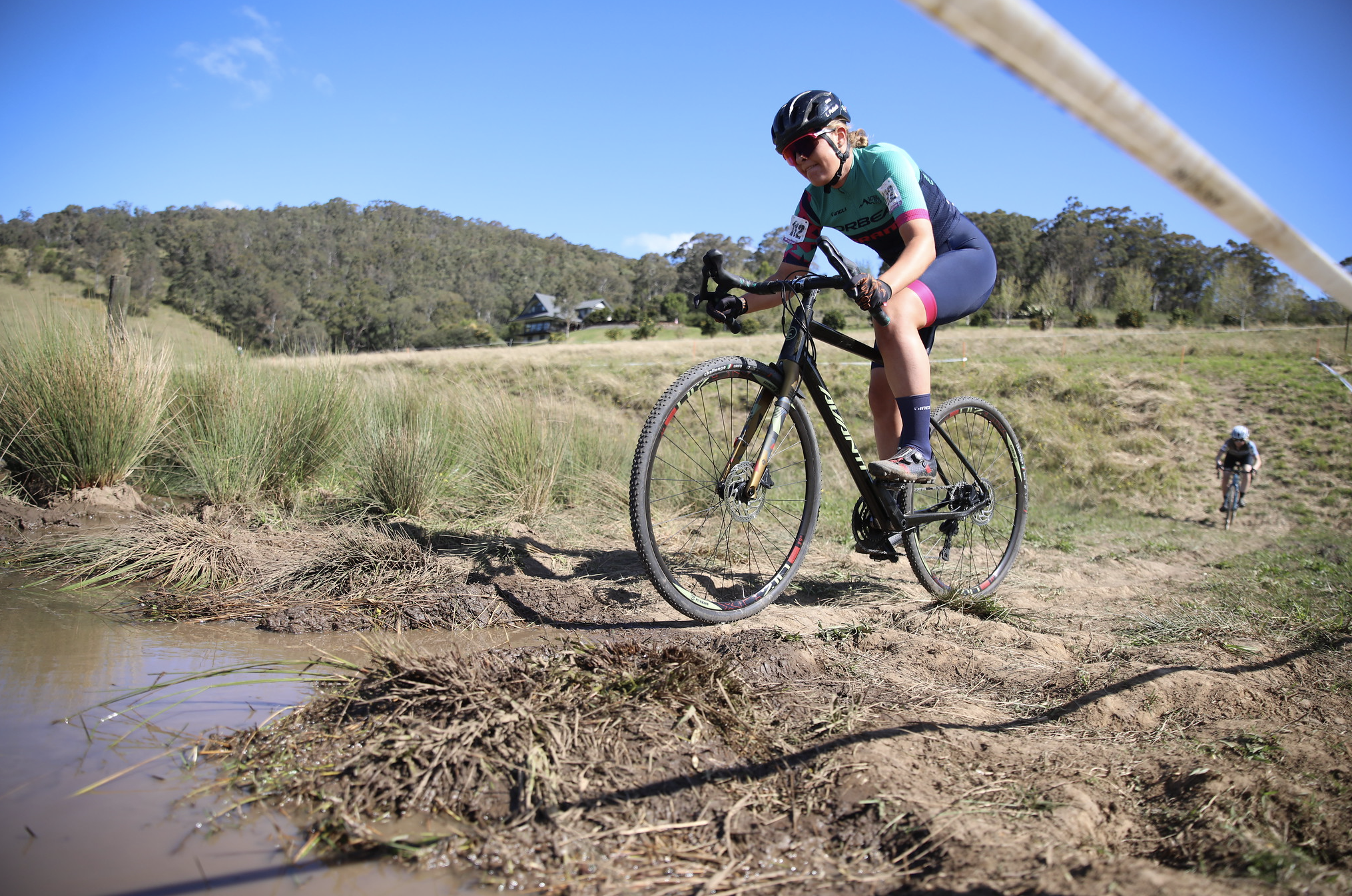Controversy surrounds disqualification of U23 Women’s race winner at Australian Cyclocross Championships
Lillee Pollock wins the sprint at the end of the U23 Women’s race at the AusCycling National Cyclocross Championships ahead of Talia Simpson. Pollock would later be disqualified due to the width of her handlebars exceeding UCI limits.
Photo: @ogaram
The finish of the U23 Women’s race at Saturday’s Australian cyclocross championships was marred by controversy, as first placed finisher Lillee Pollock (Orbea-SRAM) was disqualified after her handlebars were found to be wider than the allowable maximum under UCI rules.
After a hard-fought battle with South Australian Talia Simpson (Focus x Pedla) over the course of 50 minutes at Greenvalleys Mountain Bike Park, Pollock led out the sprint in the final straight and crossed the line in first place.
The Illawarra local’s joy was short-lived, as a post-race inspection of the Avanti Gran-Durance 3 she was riding showed that her handlebars were 5cm wider than the 50cm maximum permitted under UCI rules.
Her disqualification meant that the U23 Women’s national title was awarded to Simpson, with Zoe Davison in second and Alanna van de Hoef in third.
The final podium of the U23 Women’s race at the AusCycling National Cyclocross Championships was not reached without controversy. From L-R: Zoe Davison, Talia Simpson, Alanna van de Hoef
Photo: @thatbikenerd
The bike
The bike in question is the 2021 version of the Avanti Gran-Durance 3, an alloy gravel bike that comes as stock with handlebars that are either 441mm or 461mm wide, depending on the frame size.
Pollock, who was participating in her first ever cyclocross race at the 2022 AusCycling National Cyclocross Championships, borrowed the machine she used in her race from her dad, who placed 5th on the same bike in the Men’s Masters 5 race earlier in the day.
Crucially, the bike she used was purchased secondhand, with the stock handlebar having been replaced with a wider model before she took the start line at Greenvalleys.
Lillee Pollock grips the flared drops on her handlebars before tackling a muddy puddle at Greenvalleys Mountain Bike Park.
Photo: @ogaram
The rules
The 2022 AusCycling Cyclocross National Championships had four reference documents. From most specific to least specific for that event, they are:
The AusCycling technical guide for the 2022 Cyclocross National Championships, a link to which was sent to participants and made available on the event page on the AusCycling website
The AusCycling Technical Regulations for Cyclocross, which was made available on the event page on the AusCycling website
The AusCycling General Technical Regulations, which was made available on the event page on the AusCycling website and which governs all disciplines of the sport, including cyclocross.
The Clarification Guide of the UCI’s Technical Regulation, which clarifies equipment rules across all UCI disciplines.
The AusCycling technical guide for the 2022 Cyclocross National Championships listed the following technical requirements for bikes racing the UCI-sanctioned categories (Elite, U23 and U19):
“Level 3 - UCI Regulations (National & International)
UCI Categories
• Elite, U23, Junior/U19 - Tire width 33 mm maximum (when inflated and ready to race).
• Drop (traditional) handlebars only
• Chain drive
• 2 wheels, same diameter between 550 and 700 mm
• Shifting mechanisms/brake levers (that don’t extend excessively to become a place to rest your forearms) ”
While the width of the handlebars was not specified within the technical guide for the 2022 AusCycling National Cyclocross Championships, it is mentioned in the Clarification Guide of the UCI’s Technical Regulation, under section 1.3.012. This article governs the maximum allowable width of the handlebars for use in road, track and cyclocross competition.
Crucially, the AusCycling technical regulations guides (both the General Technical Regulations and the cyclocross-specific document) states that ‘Where any ambiguity or lack of a clear ruling exists the UCI regulations will take precedence‘ - meaning that although a specific limit on handlebar width was not included in the event’s technical guide, the UCI’s maximum handlebar width of 50cm still applied.
Although it’s normal for inspection of bikes that will be used in championships races to occur pre-race, under section 1.3.003 of the Clarification Guide of the UCI’s Technical Regulation it is legal for equipment inspections to take place before, during or after the race.
What next?
While the disqualification of Pollock was legal under the letter of the UCI’s rules, the fact remains that there could have been more done to more easily communicate the rules regarding the permitted handlebar width to competitors at this year’s Australian national cyclocross championships.
Including the stipulations regarding handlebar width as part of the event’s technical guide would not have gone astray - ideally riders shouldn’t have to comb through four separate documents on the AusCycling and UCI website in order to find out if their bike is legal to race or not.
Additionally, conducting any necessary inspections before the start of the championship race (where possible) would be advantageous - had Pollock known about her handlebars before her race began, she may have been able to borrow a compliant bike from another rider at the last minute and still compete within the rules.
Photo: @ogaram
One thing is for sure - given the recent proliferation of gravel bikes with wider handlebars (and the subsequent decline of sales in dedicated CX racing machines), this is unlikely to be the last time this particular equipment issue rears its head.
What are your thoughts on this issue? How could the situation at this year’s Australian CX Championships have been handled differently, and what changes (if any) should be made in future?








